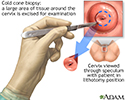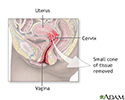Cold knife cone biopsy
Cone biopsy; Biopsy - cone; Cervical conization; CKC; Cervical intraepithelial neoplasia - cone biopsy; CIN - cone biopsy; Precancerous changes of the cervix - cone biopsy; Cervical cancer - cone biopsy; Squamous intraepithelial lesion - cone biopsy; LSIL - cone biopsy; HSIL - cone biopsy; Low-grade cone biopsy; High-grade cone biopsy; Carcinoma in situ-cone biopsy; CIS - cone biopsy; ASCUS - cone biopsy; Atypical glandular cells - cone biopsy; AGUS - cone biopsy; Atypical squamous cells - cone biopsy; Pap smear - cone biopsy; HPV - cone biopsy; Human papilloma virus - cone biopsy; Cervix - cone biopsy; Colposcopy - cone biopsy
A cold knife cone biopsy (conization) is surgery to remove a sample of abnormal tissue from the cervix. The cervix is the lower part of the uterus (womb) that opens at the top of the vagina. Abnormal changes in the cells on the surface of the cervix is called cervical dysplasia .
Cervical dysplasia
Cervical dysplasia refers to abnormal changes in the cells on the surface of the cervix. The cervix is the lower part of the uterus (womb) that open...

How the Test is Performed
This procedure is done in the hospital. You will be placed under general anesthesia (asleep and pain-free), or you will be given medicines to help you relax and feel sleepy.
You will lie on a table and place your feet in stirrups to position your pelvis for exam. The health care provider will place an instrument (speculum) into your vagina to better see the cervix.
A small cone-shaped sample of tissue is removed from the cervix . It is examined under a microscope for signs of cancer. This biopsy may also be a treatment if the doctor removes all of the diseased tissue.
Cervix
The cervix is the lower end of the womb (uterus). It is at the top of the vagina. It is about 2 inches (5 centimeters) long. The cervical canal pa...

Most of the time, you will be able to go home from the hospital the same day as the procedure.
How to Prepare for the Test
You may be asked to not eat or drink for 6 to 8 hours before the test.
How the Test will Feel
After the procedure, you may have some cramping or discomfort for about a week. For about 4 to 6 weeks avoid:
- Douching (douching should never be done)
- Sexual intercourse
- Using tampons
For 2 to 3 weeks after the procedure, you may have discharge that is:
- Bloody
- Heavy
- Yellow-colored
Why the Test is Performed
Cold knife cone biopsy is done to detect cervical cancer or early changes that lead to cancer. A cold knife biopsy is done if a test called colposcopy cannot find the cause of an abnormal Pap smear.
Colposcopy
A colposcopy is a special way of looking at the cervix. It uses a light and a low-powered microscope to make the cervix appear much larger. This he...

Cold knife cone biopsy may also be used to treat:
- Moderate to severe types of abnormal cell changes (called CIN II or CIN III)
-
Very early stage
cervical cancer
(stage 0 or IA1)
Cervical cancer
Cervical cancer is cancer that starts in the cervix. The cervix is the lower part of the uterus (womb) that opens at the top of the vagina.
 ImageRead Article Now Book Mark Article
ImageRead Article Now Book Mark Article
Normal Results
A normal result means there are no precancerous or cancerous cells in the cervix.
What Abnormal Results Mean
Most often, abnormal results mean that there are precancerous or cancerous cells in the cervix. These changes are called cervical intraepithelial neoplasia (CIN). The changes are divided into 3 groups:
- CIN I -- mild dysplasia
- CIN II -- moderate to marked dysplasia
- CIN III -- severe dysplasia to carcinoma in situ
Abnormal results may also be due to cervical cancer.
Risks
Risks of cold knife cone biopsy include:
- Bleeding
- Incompetent cervix (which may lead to premature delivery)
- Infection
- Scarring of the cervix (which may cause painful periods, premature delivery, and difficulty getting pregnant)
- Damage to the bladder or rectum
Cold knife cone biopsy may also make it hard for your provider to interpret abnormal Pap smear results in the future.
References
American College of Obstetricians and Gynecologists. Practice bulletin no. 157: cervical cancer screening and prevention. Obstet Gynecol . 2016;127(1):e1-e20. PMID: 26695583 www.ncbi.nlm.nih.gov/pubmed/26695583 .
American College of Obstetricians and Gynecologists. Practice bulletin no. 140: management of abnormal cervical cancer screening test results and cervical cancer precursors. Obstet Gynecol . 2013;122(6):1338-1367. PMID: 24264713 www.ncbi.nlm.nih.gov/pubmed/24264713 .
Baggish MS. Conization of the cervix. In: Baggish MS, Karram MM, eds. Atlas of pelvic anatomy and gynecologic surgery . 4th ed. Philadelphia, PA: Elsevier; 2016:chap 46.
Noller KL. Intraepithelial neoplasia of the lower genital tract (cervix, vulva): etiology, screening, diagnostic techniques, management. In: Lentz GM, Lobo RA, Gershenson DM, Katz VL, eds. Comprehensive Gynecology . 6th ed. Philadelphia, PA: Elsevier Mosby; 2012:chap 28.
-
Female reproductive anatomy - illustration
External structures of the female reproductive anatomy include the labium minora and majora, the vagina and the clitoris. Internal structures include the uterus, ovaries and cervix.
Female reproductive anatomy
illustration
-
Cold cone biopsy - illustration
The cold cone biopsy is a surgical procedure requiring general anesthesia and is indicated by the presence of precancerous changes in the cervix.
Cold cone biopsy
illustration
-
Cold cone removal - illustration
In the cold cone removal procedure, a small cone-shaped sample of tissue is removed from the cervix and examined under a microscope for any signs of cancer.
Cold cone removal
illustration
-
Female reproductive anatomy - illustration
External structures of the female reproductive anatomy include the labium minora and majora, the vagina and the clitoris. Internal structures include the uterus, ovaries and cervix.
Female reproductive anatomy
illustration
-
Cold cone biopsy - illustration
The cold cone biopsy is a surgical procedure requiring general anesthesia and is indicated by the presence of precancerous changes in the cervix.
Cold cone biopsy
illustration
-
Cold cone removal - illustration
In the cold cone removal procedure, a small cone-shaped sample of tissue is removed from the cervix and examined under a microscope for any signs of cancer.
Cold cone removal
illustration
Review Date: 4/5/2016
Reviewed By: Irina Burd, MD, PhD, Associate Professor of Gynecology and Obstetrics at Johns Hopkins University School of Medicine, Baltimore, MD. Review provided by VeriMed Healthcare Network. Also reviewed by David Zieve, MD, MHA, Isla Ogilvie, PhD, and the A.D.A.M. Editorial team.



